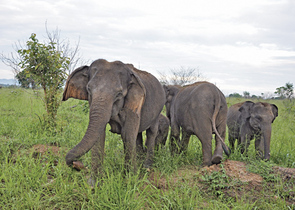Nature Conservation 2/2012 — 23. 8. 2012 — International Nature Conservation — Print article in pdf
Májsky J.: What is Wrong with National Parks in Southern Sri Lanka?

The Bundala, Uda Walawe and Yala National Parks (NPs) situated in southern Sri Lanka are covered mainly by partially deciduous monsoon forests, thornbush with grassland patches, at some sites also by wet monsoon forests. Diversified habitats harbour species-rich fauna there.
Annually, approx. 200,000 tourists visit the NPs, particularly due to species-rich bird fauna (the Bundala NP has become a Wetland of International Importance under the Ramsar Convention) and particularly large herbivores. Herds of the Asian Elephant (Elephas maximus), deer, namely the Chital (Axis axis) and Sambar (Cervus unicolor), and of the domestic Asian Water Buffalo (Bubalus bubalis), the feral descendent of the non-native Wild Water Buffalo (B. arnee) occur there. Because from large carnivores, only the rare Sri Lankan Leopard (Panthera pardus kotiya) inhabits the area and large herbivore populations are not regulated by hunters, large areas are overfertilized by wild animal dung and faeces. The fact influences plant communities: particularly drier bush habitats are strongly invaded by non-native plants, e.g. by the Spanish Flag (Lantana camara), Erect Prickly Pear (Opuntia strictavar. dillenii) and the Siam Weed (Chromolaena odorata). The ecosystem degradation is indicated also by some native species, e.g.by the Crown Flower (Calotropis gigantea). Seemingly primary wilderness shall probably need regulatory measures to be carried out by the Sri Lankan Nature Conservancy authorities.

